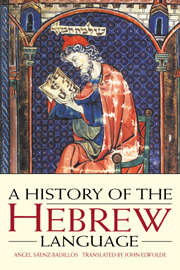Book contents
- Frontmatter
- Contents
- Foreword by Shelomo Morag
- Acknowledgements
- 1 Hebrew in the context of the Semitic languages
- 2 Hebrew, a Northwest Semitic language
- 3 Pre-exilic Hebrew
- 4 Biblical Hebrew in its various traditions
- 5 Hebrew in the period of the Second Temple
- 6 Rabbinic Hebrew
- 7 Mediaeval Hebrew
- 8 Modern Hebrew
- Bibliography
- Index
3 - Pre-exilic Hebrew
Published online by Cambridge University Press: 05 June 2012
- Frontmatter
- Contents
- Foreword by Shelomo Morag
- Acknowledgements
- 1 Hebrew in the context of the Semitic languages
- 2 Hebrew, a Northwest Semitic language
- 3 Pre-exilic Hebrew
- 4 Biblical Hebrew in its various traditions
- 5 Hebrew in the period of the Second Temple
- 6 Rabbinic Hebrew
- 7 Mediaeval Hebrew
- 8 Modern Hebrew
- Bibliography
- Index
Summary
The historical unity and development of Hebrew
Hebrew has a long history. It has persisted as a written language for more than 3,000 years. As a spoken language, it has had to survive in many different situations, following the complicated historical course of the Jewish people, which has spent more than half its existence in a bilingual setting, adapting to a wide range of cultural and linguistic environments. Such a history has left obvious and important marks on the language.
Nonetheless, from one perspective, especially if we concentrate on the written language, it is possible to speak of the historical unity of Hebrew throughout its existence. The language has remained substantially the same down the years, undergoing changes that have appreciably affected its vocabulary but not, on the whole, its essential morphological, phonological, or even syntactic structure. The truth of this statement even extends to the Hebrew spoken and written today, following a fascinating process of revival. The fundamental unity of Hebrew, both its language and its literature, is beyond doubt.
Not only have the basic structures of the language, its morphological system, and especially its verbal morphology, been preserved without major changes over the centuries, but it is also possible to claim that the vocabulary of the Bible has been the basis for all later periods, despite the numerous innovations of each era.
Nonetheless, we cannot ignore the deep differences that also characterize each stage of the language, and the many factors that have led historically to its diversification.
- Type
- Chapter
- Information
- A History of the Hebrew Language , pp. 50 - 75Publisher: Cambridge University PressPrint publication year: 1993



